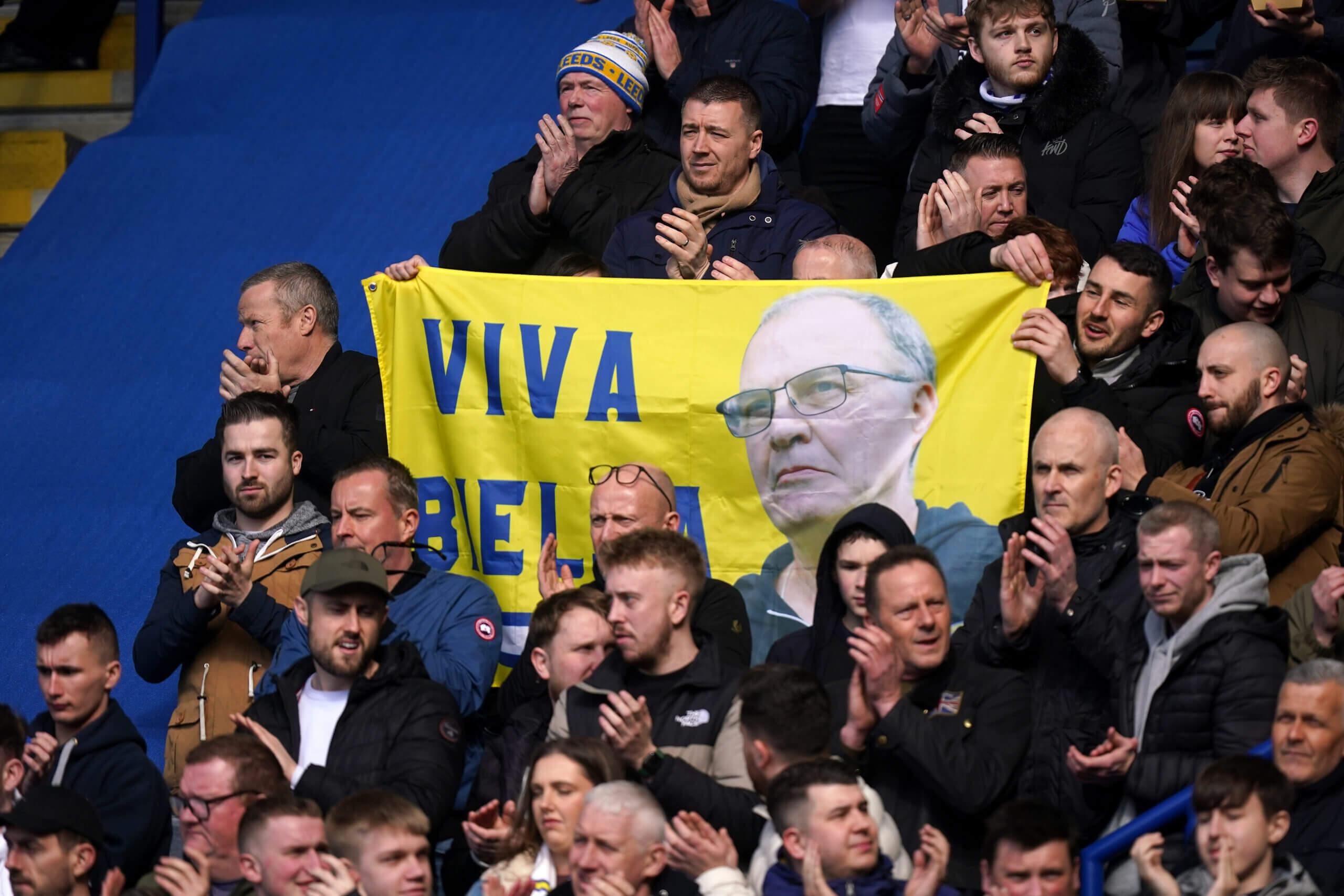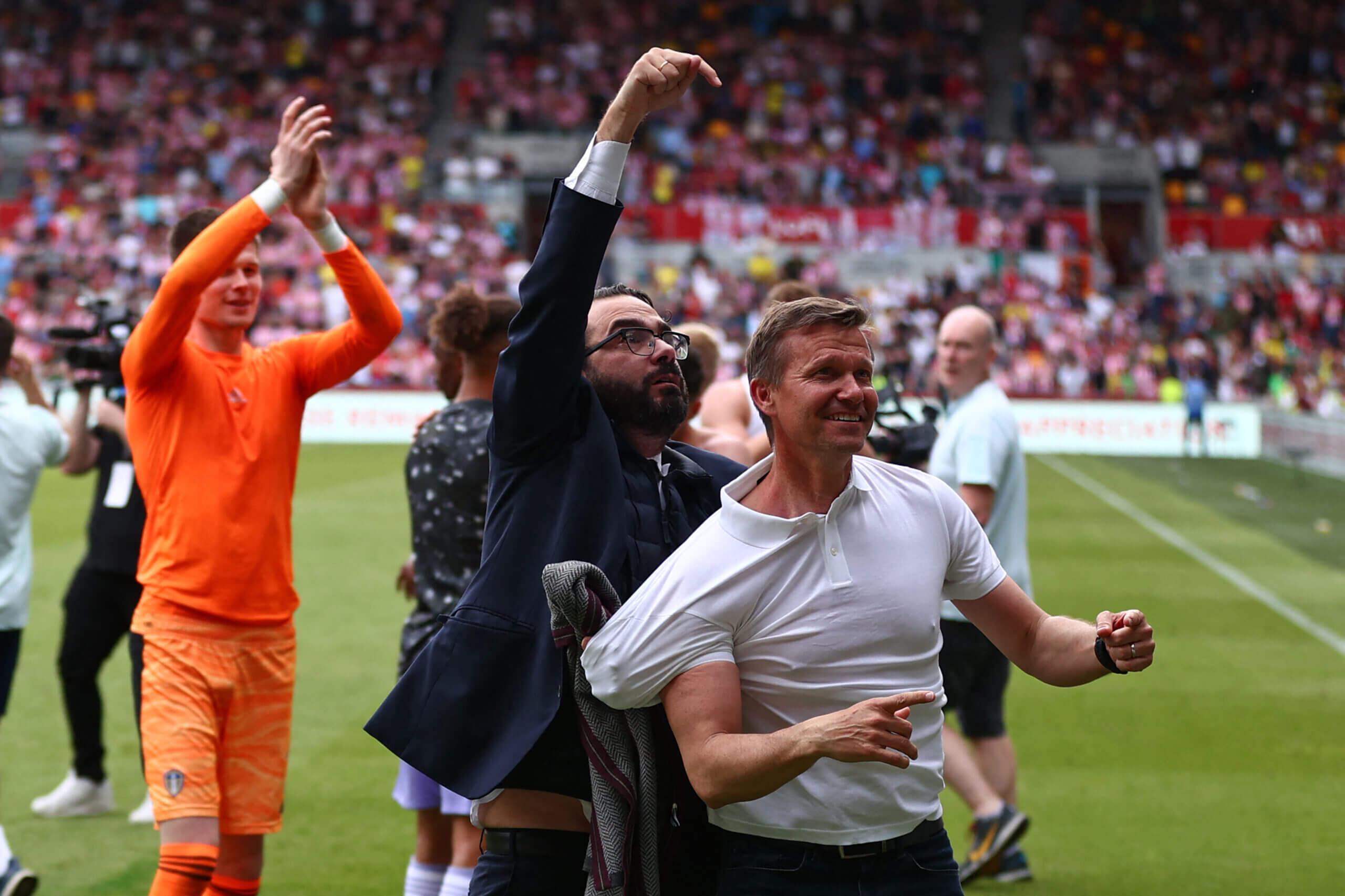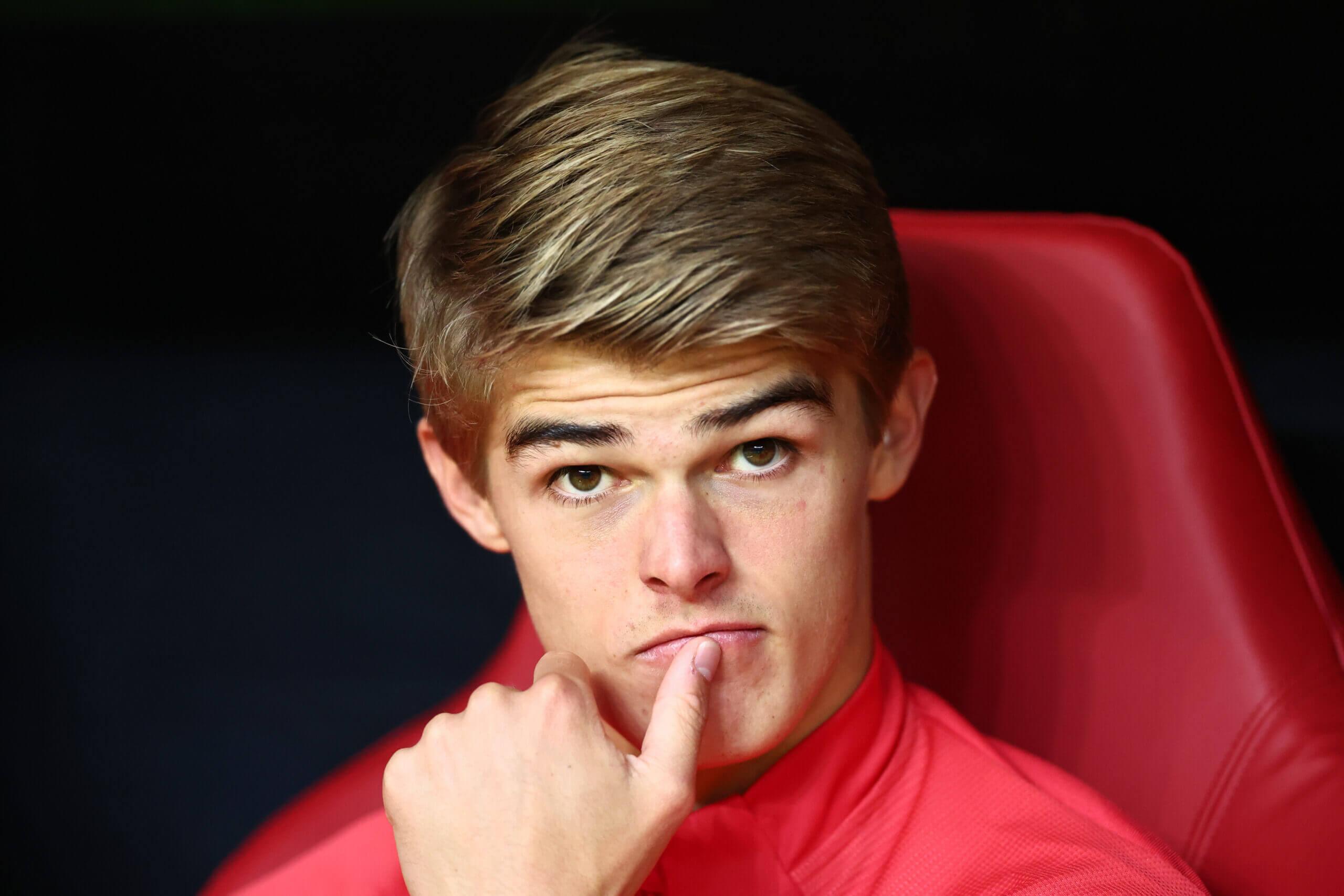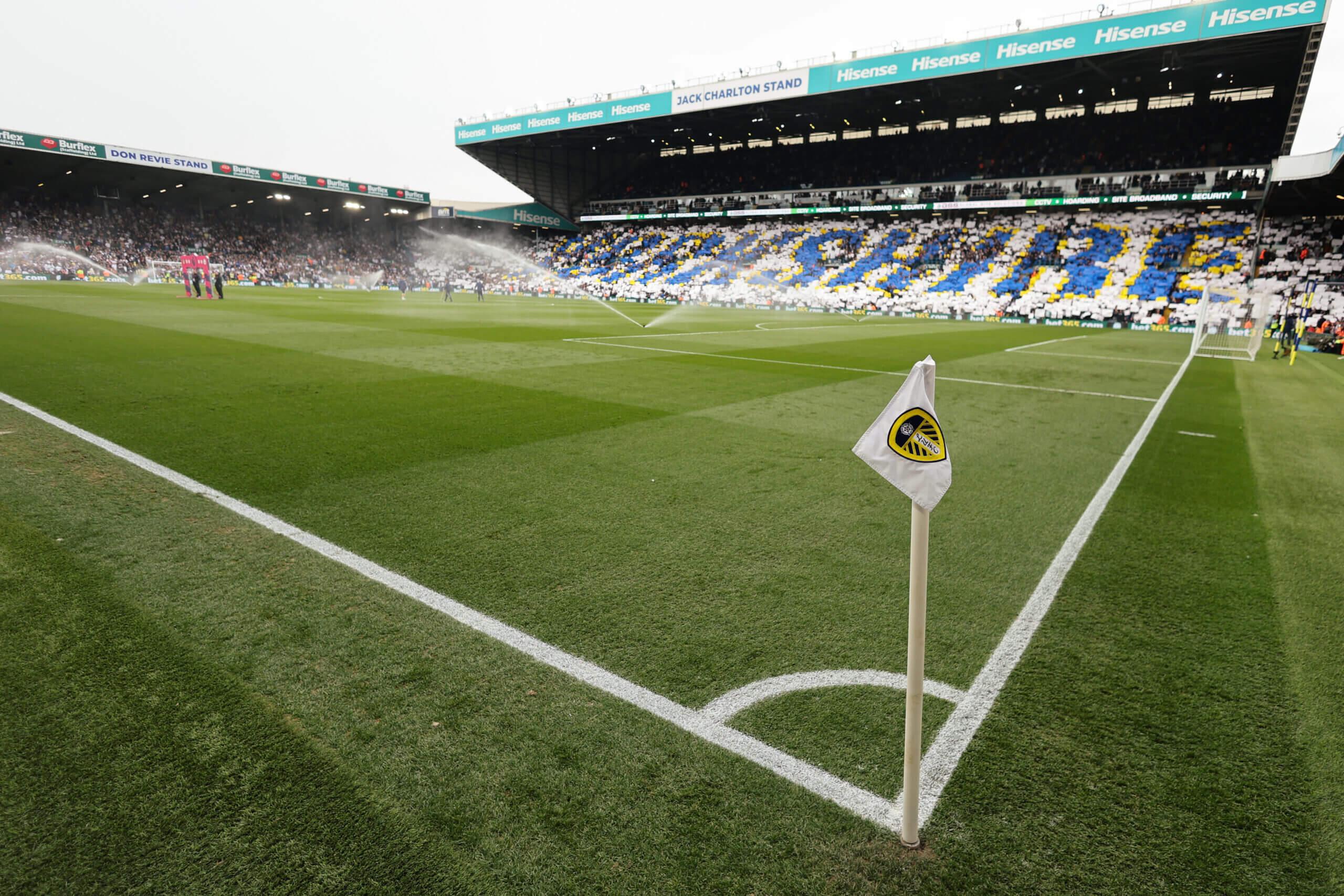Leeds owner Radrizzani: ‘I had to decide to potentially die with Bielsa or someone else’
86
Andrea Radrizzani’s opening gambit is to say that he will happily talk about anything, with no subject off limits. Some time has passed since he last sat down for an interview and he tells us he prefers to field questions about Leeds United in one hit, rather than via a running commentary week to week.
His son is with him and Radrizzani looks relaxed, which tells you that the new Premier League season is nigh. Owners, coaches and players carry a twinkle in their eye — a fresh start allows optimism to flourish without results snapping at their heels. As Radrizzani proved earlier this year, the tail-end of winter and the sharp end of the fixture list is when football often finds them wearing a stressed and haunted look.
Radrizzani, the Italian businessman who bought Leeds from Massimo Cellino for £45million ($55m) in 2017, is on the cusp of his sixth season as the club’s chairman and majority shareholder. He is also moving on from the harshest of them, a year in which all that was gold at Elland Road no longer glittered with the same sparkle. May 22 was like a toss of a coin for Leeds: heads they stay up, tails they go down. The club’s status and value of half a billion pounds staked on one match. “It was a mix of emotion between hope and fear in the 90 minutes,” Radrizzani says. “But I was confident.”
The coin fell favourably and Leeds danced around relegation, but how it came to that — three years of magical growth at Leeds giving way to a close brush with relegation — is something he has not spoken about publicly. Why did he sack Marcelo Bielsa with 12 games of the season to go? What stopped him from standing by the most successful and popular Leeds coach in a generation? Will the change of direction instigated by the appointment of Jesse Marsch as Bielsa’s replacement work? What of the transfer window and of Radrizzani himself, someone who said he would walk away from Leeds if or when the club reached Europe?
The sun is shining at Thorp Arch and Radrizzani is sitting in a first-floor room, the games room Leeds built for their squad at Bielsa’s request. The log burner Bielsa wanted his players to light and tend to every day is to Radrizzani’s right and for the best part of an hour, it is an open forum. So much has happened in the past 12 months that it would be difficult to know where to start, save for the fact that the only feasible starting point is obvious to everyone.
Marcelo Bielsa
Leeds parted company with Bielsa on February 26, 170 games into his tenure. As impressive as they were, his career at Elland Road was too unique to be defined by numbers and his impact, professionally and culturally, too big to overstate, a line in the sand between a decade of meandering incompetence in the EFL and the clearest of visions about how to escape it. Over time, Leeds pushed his salary towards the top end of the Premier League’s managerial wage bill.
But last season the impetus ran dry, to the point where high-level faith went with it. It was Radrizzani’s decision to change head coach, rather than a mutual separation, a chairman who no longer believed in his coach. Bielsa was committed to seeing the season out, gritting his teeth as results eluded him.
“I told him face to face,” Radrizzani says. “It was very different to every meeting I had with him. In every meeting normally, he was open to a long conversation. In this case, he probably didn’t expect it because I always supported him unconditionally. I saw him hurt and speechless for the first time.”
The change in the wind at Leeds was quick. As recently as the end of January, the message at board level was that the club were sure they had what they needed to reach safety, despite signing no players in that window. Radrizzani says he first began thinking about a change during a 3-3 draw at Aston Villa on February 9, a game in which Leeds bounced from 1-0 up to 3-1 down before fighting back to earn a draw. Villa’s goals were scored in 13 first-half minutes, their defence splitting apart.
“I’d never thought to sack Bielsa,” Radrizzani says. “I never thought this moment could happen, ever,” although he admits Leeds were already resolved to change manager when Bielsa’s contract expired this summer, even if relegation was averted. “He was a legend and he is a legend for what he achieved.
“The moment I started to have a doubt was (at Villa) when we drew 3-3. I remember the media talking positively about our performance. The reality for me, at half-time I almost wanted to leave the stadium because I was so disappointed by the lack of discipline on the pitch, how easy it was to score against us. That was the first moment I realised maybe something’s wrong and the team cannot execute anymore what he’s been asking for the last years. They had started to become tired, mentally more than physically.
“I felt something was broken and that’s when you have a tipping point, but it was too soon to take a decision.” It came instead on February 20, in the aftermath of a 4-2 defeat to Manchester United. Leeds recovered from 2-0 down to level the game but lost 4-2 with two concessions in the last quarter. Radrizzani says his mind was made up then but, after consulting the club’s board, they held for another two matches, a 6-0 defeat to Liverpool and a 4-0 defeat to Tottenham Hotspur. Those results left Leeds two points above the relegation places.

Radrizzani says he saw Bielsa “speechless for the first time” after telling him of his sacking (Photo: Mike Egerton/PA Images via Getty Images)
Everything had conspired against them: injuries, a painfully thin squad, tactics that were no longer working but that Bielsa refused to tweak, preferring to stick to his guns. “At the end, I realised Marcelo had only one way, that he could not compromise with this way,” Radrizzani says. That was not a secret, though. Bielsa had committed to one plan, one style of play, from the outset and prior success spoke for itself. In the periods where the quality of the football dipped before, he had always brought patches of poor form to heel.
Within Leeds’ fanbase, there was anger over Bielsa’s dismissal and a feeling that after delivering so much as head coach, he should have been given the chance to do or die in the final 12 games. “I expected that (the critical reaction), but I needed to think about the club,” Radrizzani says. “I could see that the players, emotionally and physically, were really at the end.
“We needed to change, we needed something to impact the group. It was risky both ways. It wasn’t easy to decide whether to potentially die with him or die with someone else.” But was he convinced the squad were going down with Bielsa? “Yes.”
According to Radrizzani, Bielsa’s departure was not instigated by the players or encouraged by them. “They were supportive of him,” he says. “They were behind him, mostly because of the legacy of what they had done together. They’d go with him. But the next day when we arrived with Jesse Marsch, I have never seen the atmosphere so changed and so happy. Something was spoiled inside and until the moment when we changed things, it couldn’t come out.”

Leeds fans reacted angrily over the sacking of Bielsa (Photo: Mike Egerton/PA Images via Getty Images)
In prior conversations between them, Radrizzani says Bielsa accepted himself that his methods would not work forever; that because of the intensity of his coaching and tactics, Leeds would one day need a new coach or an entirely new squad, a refresh one way or the other. All the same, they did not anticipate the extent of the dip ahead of them last season. So who was primarily responsible for the problems? Where did the blame truly lie?
“Mainly with me and Marcelo for not changing in time,” Radrizzani says. There is almost a hint that by going into season four with Bielsa and a squad still laden with many of the players promoted with him, Leeds were pushing the envelope too far. “We had this conversation in the summer. We knew, both of us, that either we should change all the players or change him. He was very open to admit that, because obviously the regime and the way he conducts his leadership is very demanding.
“His strength is the discipline and one way of work. He doesn’t compromise with his idea of football. But his strength is also his weakness. The lack of adaptation and flexibility took it to the end.”
Radrizzani is hopeful of meeting Bielsa again and Leeds have written to him asking permission to name their training ground after him. The club promised a permanent tribute to him in the statement they released when they sacked him and, having talked at first about creating something outside Elland Road, have settled on the training ground plan instead.
“I also have an idea that I shared with him, that one day I would love to build a university of football with his name (on it),” Radrizzani says. “I hope he will still be open to that idea. My respect and my consideration will never change.” It was, for so long, the best of times.
Jesse Marsch
Having agreed to replace Bielsa, Marsch arrived in England some 12 hours after the Argentinian’s departure was announced and met Leeds’ players at Thorp Arch for the first time the next day. The club’s director of football, Victor Orta, had picked out him and a handful of other names from a list of more than 40 coaches he had monitored over the previous two years, preparation for the day Bielsa left.
Had Bielsa not extended his contract at the end of the 2020-21 season, and had Marsch not already been taken on by RB Leipzig at that stage, the appointment might have happened then. Latterly, a plan was in place for Marsch to replace Bielsa at the end of last season, a plan expedited by Bielsa’s unexpected dismissal.
“We already had Jesse in mind,” Radrizzani says. “When the crisis hit we talked to him and, to be honest, I’m very grateful he took the challenge because it really was a challenge. He came in the most difficult way, to come after Marcelo, a legend for this club, and in a difficult situation on the football side. I love the man. I think this year, he will have time to show me he’s a great coach, but the man has already got me completely.”

Radrizzani hopes Marsch, pictured with Orta, will prove himself a top coach this season (Photo: Adrian Dennis/AFP via Getty Images)
At Brentford, Marsch, like Radrizzani, was 90 minutes away from having relegation on his record, albeit in circumstances where others would have carried the can first. After inheriting Bielsa’s players, he struggled to establish a system that worked and was unable to guide Leeds to safety before the season’s final weekend. But survival allowed Leeds to make a concerted effort to build a squad in his image this summer and, in pre-season at least, the implementation of his tactics has looked far more thorough.
“Last year it wasn’t his team,” Radrizzani says. “It was a job he did excellently in terms of motivation, keeping the group together, keeping them focused. I’m very, very pleased with what he delivered. He was brave and he has been a leader, absolutely a leader. Now it’s his team. There are similarities with Bielsa but maybe it will be more vertical and also we defend differently. We don’t defend any more man-to-man. There’s more flexibility. So we’ll see and I’m excited to see.”
Leeds’ primary aim in their first two seasons in the Premier League was to avoid relegation, but their second year proved that scraping 17th, as much as it ticked that box, incurred untold stress and negative consequences. They have signed five proven first-team players in this window along with under-21s Darko Gyabi and Sonny Perkins. Three of those signings have played for Marsch previously and all of them have been recruited to fit into his system. The makeweight was the sale of Leeds’ two most valuable assets, Kalvin Phillips and Raphinha.
“This year, in my opinion, we’ve done a great job in the market and we have a very competitive team,” Radrizzani says. “The target I set is between 10th to 14th position. If we’re lucky, we are close to 10th or more. If we aren’t lucky, we are 15th. But I think we are in that range. I don’t want to have any more heart-attack risk.” But is there any chance in his mind of a relegation battle? “I don’t have any doubt that we’ll avoid a situation similar to last season,” he says. “It’s impossible.”
Phillips and Raphinha
One of the narratives at Leeds for some time now has been Radrizzani’s interest in the Leicester City model: the concept of a club selling their best players at peak value to improve the squad as a whole. Leeds have gone down that route since May, losing Kalvin Phillips to Manchester City for £43million and Raphinha to Barcelona for £50million. It was, in no small way, the first test of Leeds’ ability to cash in and skillfully reinvest.
Radrizzani says losing Raphinha was always on the cards this summer to fund incoming transfers. “It was more a sacrifice to buy the players we needed to reinforce the squad,” he says. “We cannot do another three years spending £100million without any (transfer) income. The club will collapse. This is the first year in the Premier League that we sold players.”
Phillips to City was different, a deal Leeds sanctioned after Phillips told them directly he wanted to move to the Etihad. “I didn’t want to let him go,” Radrizzani says. “He decided to go and was very clear to me that it was his ambition to play at that level.”
There is a natural concern, though, that in allowing two high-profile exits in the space of a month, Leeds have made themselves weaker. In the meantime, reinforcements have come in the form of midfielders Marc Roca, Tyler Adams and Brenden Aaronson, winger Luis Sinisterra and right-back Rasmus Kristensen. Radrizzani’s opinion is that the trade-off has put the club in a stronger and more competitive position.
“It’s a good question,” he says when asked if Leeds are weaker without Phillips and Raphinha. “I think no. We have lost two champions, two big players, but we got six good players (a number that includes Gyaby, who Leeds regard as a first-team player despite his lack of experience). The team needed more solidity, more options and a bigger squad. So six good players in my opinion makes a difference rather than two big players. I might be wrong, but this is my conviction. I think the pitch will show it.”
Leeds feel Raphinha’s success in particular will give them more clout in the market when it comes to attracting the best European prospects in the stage before their careers peak. It should allow them to sell the club as a stepping stone. Politically, however, auctioning prime talent is a delicate balance. How long will the crowd at Leeds tolerate this model of recruitment? Might patience wear thin if top player after top player moves out of Elland Road each summer?
“These two deals, Raphinha and Phillips, are important, not only to give us the opportunity to buy but also to be perceived by other talented players as a destination before they go to the big club,” Radrizzani says. “That’s what we need to be now, I think. The fact you can come here, play for two or three years and go to Madrid or Barcelona or Manchester City, that is something to be proud of. We need to be realistic. We cannot be at that level.
“But over time we will have to be better at keeping some players. This is not a forever strategy. In the medium to long term, we will be able to maintain some of the talent. We don’t want to sell our talent every time.”

Radrizzani believes Leeds have not been weakened by the loss of Phillips and Raphinha after reinvesting the funds (Photo: Getty Images)
Raphinha joining Barcelona was a ludicrously complex process, in keeping with the mayhem emanating from Barca. Leeds first agreed a deal with Chelsea, one Radrizzani would rather have pushed through — “for me, it was done, and when I have a deal my word is my word. I felt ashamed to go back to (Chelsea owner) Todd Boehly and change my position” — but Raphinha’s insistence on moving to Camp Nou, persuaded by what Radrizzani calls “Barcelona influences”, forced Leeds to wade through a protracted solution with the La Liga club.
“We made the deal with Chelsea because the player wanted to go and he was open to listening to offers from Premier League clubs,” Radrizzani says. “Chelsea was in his favourable (option).
“But unfortunately, let’s say Barcelona influences convinced the player to wait, to wait, to wait until they could find a solution. This shows again the power and the leverage players and their agents have in the system, which for me is exaggerated, too much. We do a lot of investment to build clubs. We invest hundreds of millions but all the power it seems to be (with) agents and representatives of these players.”
One of the worries for Leeds was whether Barca had the money to pay for him, which is why the final contract included a penalty clause punishing late payment. Radrizzani says he expects the cash to arrive as agreed. “It would be ridiculous (if it did not), I could not imagine something like that happening,” he says. “If not, we will have a global case about Barcelona.”
Recruitment
It is certainly true that in their first two Premier League seasons, Leeds did not finance their business by selling anyone of note. But there is a constant theme of discussion at Elland Road about whether the money invested in those two years, well over £100million on players, had the desired effect; about whether the success of individual signings has been good enough, particularly in light of how close the club were to relegation in May.
“When you mention about the market, you’re right,” Radrizzani says. “But I don’t think there is a club who nail every single player they purchase. We should put a line after three to five years to see how many players were successful or not to find a judgement over a period of time. We have cases where maybe the performances have not been at the level of investment. Then we have other cases the opposite. Illan Meslier is a fantastic example.”
Radrizzani is happy about the fact that of the six first-team-ready targets identified before the window opened, Leeds landed five. Charles De Ketelaere is the one who got away, the supremely gifted Belgian forward signing instead for AC Milan this week. Radrizzani tells The Athletic that Leeds were in agreement with Club Bruges over a £33.5million fee for De Ketelaere and that at one stage, his decision between Leeds and Milan was “50-50”.
“He was our icing on the cake, the special player,” Radrizzani says, “but we were competing with AC Milan. They won the title, they have the Champions League. The fact that he was watching our documentary and was 50-50 about Milan or Leeds for a period makes me proud that we are in the right direction. Maybe I should have gone to Belgium 1o days (earlier) to close the deal. We had a period when I knew Milan were sleeping because of the change of ownership and I hesitated. We were agreed with Bruges on €40million.”
The average observer would say that having missed out on De Ketelaere, Leeds still need another forward. There is an argument to say that an extra left-back would be prudent, too. Leeds have looked at other attacking players, including Arnaud Kalimuendo at Paris Saint-Germain and Martin Terrier at Rennes. Radrizzani describes the club as “active” in the market but says the hunt for an alternative to De Ketelaere is taking into consideration the need to let Joe Gelhardt play and flourish.

Charles De Ketelaere chose AC Milan over Leeds (Photo: Robbie Jay Barratt – AMA/Getty Images)
“I have a lot of confidence in ‘Joffy’ Gelhardt and Patrick Bamford coming back this season but we’re actively monitoring and discussing with Jesse and Victor,” Radrizzani says. “We don’t have to do a deal at any cost. Charles De Ketelaere was a special player. We were all in agreement to make a big effort. With other players, unless we are convinced 100 per cent that we improve, we don’t move.”
But wasn’t that part of the issue last season? That Leeds were short of resources in certain positions and suffered because of it?
“Yes, true, but we are discussing a lot about a striker,” he says. “If we bring (in) a young one, we tend to kill a space for Gelhardt, who I believe is one of the most talented strikers in the country for his age. His numbers talk. Every time he plays he has an impact. It’s not an easy decision. But if we find the right player and we’re convinced, we’ll bring him in.”
As for Jack Harrison to Newcastle United, Radrizzani kills the link stone-dead. “Absolutely not,” he says. “There is no way. Jack stays here.”
Boardroom investment and stadium development
The 2021-22 season was a new — and presumably unenjoyable — experience for Leeds’ minority shareholder, 49ers Enterprises. After the investment arm of the San Francisco 49ers first bought into Leeds in 2018, the club’s rise felt limitless: the play-offs with Bielsa, promotion with Bielsa and then, at the first time of asking, a ninth-placed finish in the Premier League.
In contrast, the campaign behind them brought into sharp focus the reality of English football and the jeopardy involved in club ownership here. The absence of a franchise system or the safety net of competitions without relegation meant Radrizzani was not the only party at Leeds who stood to see the value of his investment drop dramatically had Marsch and his squad not found a way out of trouble at Brentford.
When it first invested four years ago, 49ers Enterprises acquired a 10 per cent stake from Radrizzani. Its equity share climbed to 37 per cent during the 2020-21 season and 44 per cent last November, purchases that provided Leeds working capital. As yet, there has been no more movement on that front and Radrizzani does not expect any imminent change in the split of shares. Selling Phillips and Raphinha lowered the pressure for fresh funding from the club’s shareholders.
The Athletic has previously reported that 49ers Enterprises holds an option to buy Radrizzani out before a set date in 2024. With 44 per cent of Leeds already in its possession, the next tranche of shares it purchases would most likely take it over 50 per cent, replacing Radrizzani as majority shareholder.
“There is no need to change,” Radrizzani says. “I’m happy. I dream to bring this club to play in Europe and then I’m happy to leave — so still some work to do here. We are very good friends with the 49ers, they are a solid partner, they let you work in peace and they are supportive. In this moment, there is nothing under discussion. They have, as you know, an option to take a majority in 2024. Maybe before or at that moment, something will be discussed. At this moment, we are super happy.”
Radrizzani accepts that neither he nor 49ers Enterprises have the financial might to match that of Europe’s most powerful teams, but he aims to push Leeds’ annual turnover over the £250million mark, thereby giving them the resources to be prominent below the Premier League’s top six. Hitting that target will partly rely on expanding Elland Road and increasing the stadium’s capacity from 36,000 closer to 60,000. Aside from the commercial benefits, it would also satisfy a season ticket waiting list with more than 20,000 names on it.

There are long-term plans to expand Elland Road (Photo: Matthew Ashton – AMA/Getty Images)
Leeds have spoken repeatedly about redeveloping the ground and they are understood to be involved in regular meetings with the city council. They have produced architectural drawings and completed a feasibility study. Radrizzani estimated the cost of the upgrade at more than £100million, but says progress has been made in securing funding.
“I always said to Angus Kinnear (Leeds’ chief executive), we’ll look at the expansion of the stadium when we’re in the third year of the Premier League,” Radrizzani says. “The chance to go back in the Championship is very high in the first and second year but much lower after.
“Now we can move on. Angus has initiated some activities to finance the project. It will be over £100million to renovate the West Stand and build it to a 55,000 capacity. We’re going step by step but, hopefully, we move soon with a financial partner.”
The Bielsa era drove huge growth in the interest in season tickets at Leeds. The growing American presence at Elland Road, meanwhile, has given the club scope to angle for a new audience of supporters in the States, a market many Premier League clubs have tried to tap into. Radrizzani says the wealth of US links at Leeds is “a pure coincidence” but they have American shareholders, an American coach and two US internationals on their books. Awareness on the other side of the Atlantic has increased steadily.
“We now see a massive gulf in all things America,” he says. “Obviously we need to react in terms of marketing and off-pitch activities, PR, merchandising. But to be honest, the way we built this triangle between the part-ownership structure, the coach and the players is a pure coincidence. Aaronson was a player we decided to have with Bielsa, before Jesse.”
So soon after beating relegation — and it has barely been two months — Radrizzani is very confident about a better year ahead. He thinks the signings made so far are sensible, players with international experience increasing the size of Marsch’s squad, and he does not fear that a relegation battle might suck Leeds in again.
The club have had an odd experience of the Premier League since returning to it. Bielsa’s side were largely brilliant in their first year back but with the exception of two games, COVID-19 forced them to play in front of empty stadiums. Last season was a trial that took its toll in so many ways. It was a campaign that, in Liam Cooper’s words, never got going. “This should be the season we enjoy,” Radrizzani says.
The strain of the Premier League run-in in the wake of Bielsa’s dismissal spoke for itself. There were protests against Radrizzani and the board after a 3-0 defeat to Aston Villa, which was Marsch’s first home game. There were more during a 1-1 draw with Brighton on the penultimate weekend. There was a return to fear and loathing, something Leeds used to do well until the appointment of Bielsa tied all the emotional threads together.
“Sometimes I need to do my job to save the ship,” Radrizzani says. “I suffered a lot of criticism last season, the first time in my life I was abused by people literally at the stadium. I didn’t feel I deserved it. I’ve always done my best and put my time and money into the club.
“I was not born here. It became my club as part of a project. For 90 minutes, I’m the No 1 fan. After, I’m a manager, an owner and nothing to do with the fan. It has been like this from day one and it will always be.” And just like that, the curtain rises again.
